Report on Tax Concessions for Small Businesses in Australia - MA613
VerifiedAdded on 2023/06/11
|8
|2367
|164
Report
AI Summary
This report provides an overview of tax concessions available to small business entities in Australia, focusing on those with a sales turnover of less than $10 million. It highlights the significance of these entities to the Australian economy and the special tax treatments offered by the Australian Tax Office (ATO) and the federal government. Key concessions discussed include Capital Gains Tax (CGT) relief, such as the 50% reduction on gains from active asset disposals and the 100% exemption for assets held for over 15 years, particularly beneficial for owners at retirement. The report also covers simplified depreciation rules, allowing assets to be treated as a single item for tax-deductible purposes, and the ability to claim prepayment expenses in advance. Furthermore, it details the advantage of using the cash basis method for income tax and Goods and Services Tax (GST) accounting, enabling businesses to pay taxes only on actual earnings and receipts. Finally, the report mentions the income tax concession involving a tax offset, reducing the tax burden for eligible small businesses. These concessions aim to ease the financial burden and promote growth among small business entities.
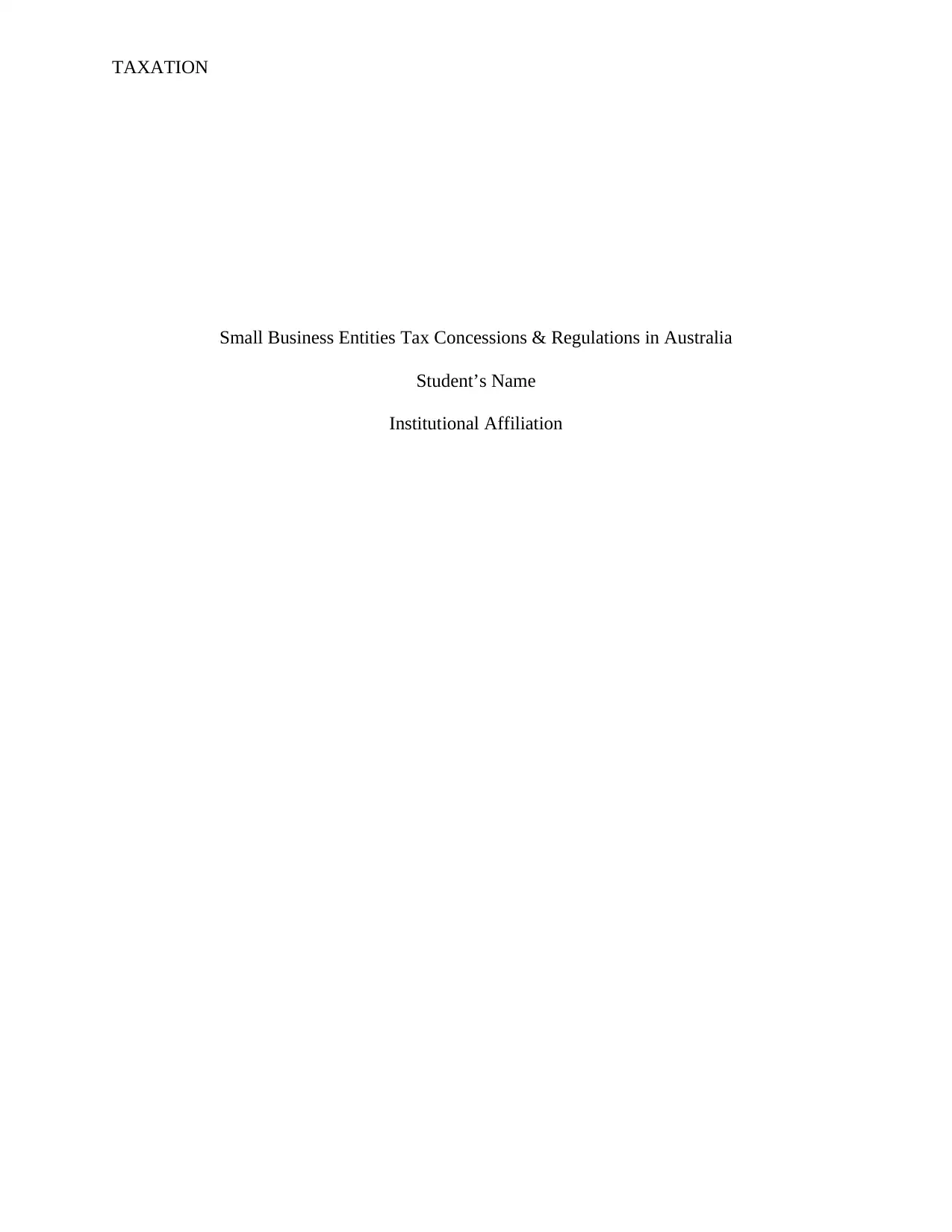
TAXATION
Small Business Entities Tax Concessions & Regulations in Australia
Student’s Name
Institutional Affiliation
Small Business Entities Tax Concessions & Regulations in Australia
Student’s Name
Institutional Affiliation
Paraphrase This Document
Need a fresh take? Get an instant paraphrase of this document with our AI Paraphraser
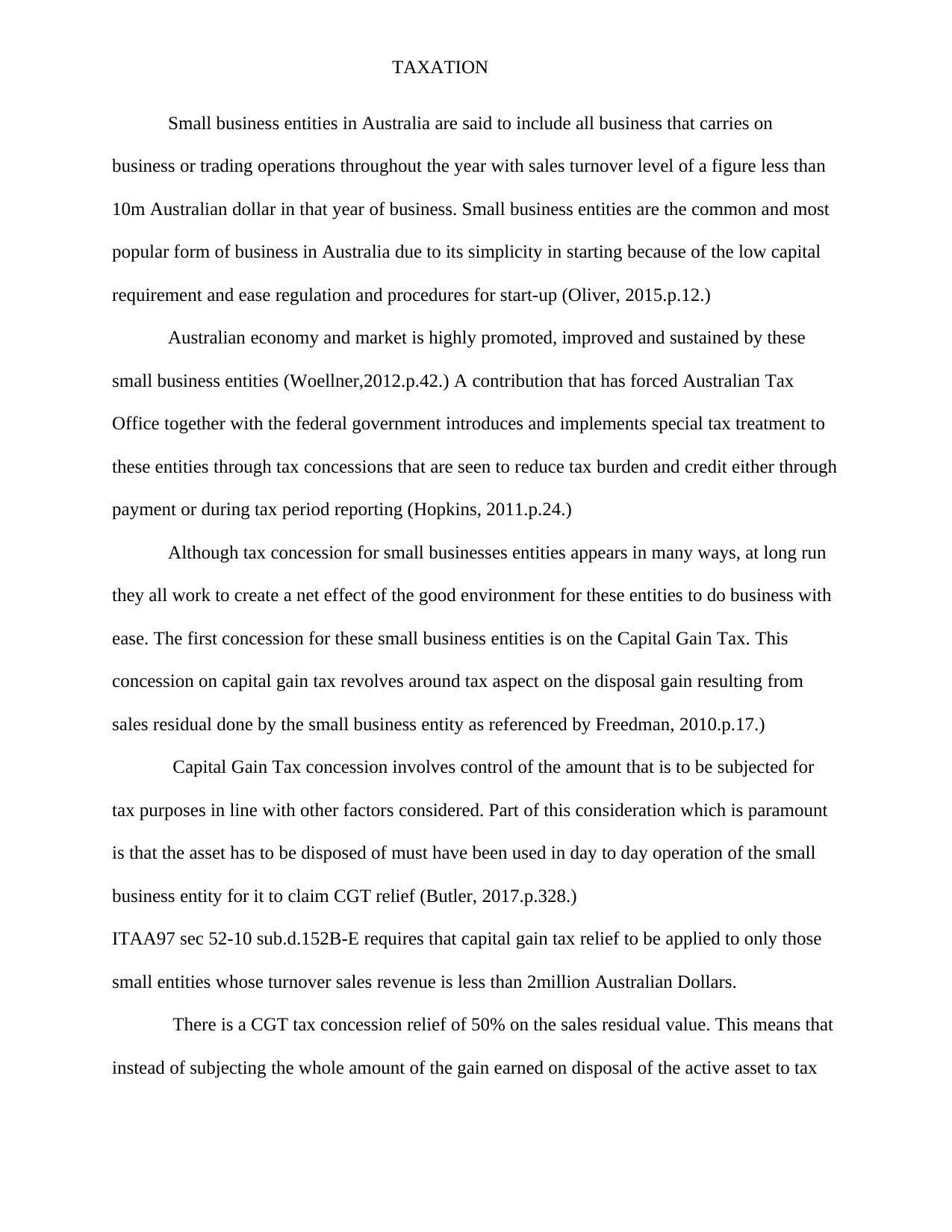
TAXATION
Small business entities in Australia are said to include all business that carries on
business or trading operations throughout the year with sales turnover level of a figure less than
10m Australian dollar in that year of business. Small business entities are the common and most
popular form of business in Australia due to its simplicity in starting because of the low capital
requirement and ease regulation and procedures for start-up (Oliver, 2015.p.12.)
Australian economy and market is highly promoted, improved and sustained by these
small business entities (Woellner,2012.p.42.) A contribution that has forced Australian Tax
Office together with the federal government introduces and implements special tax treatment to
these entities through tax concessions that are seen to reduce tax burden and credit either through
payment or during tax period reporting (Hopkins, 2011.p.24.)
Although tax concession for small businesses entities appears in many ways, at long run
they all work to create a net effect of the good environment for these entities to do business with
ease. The first concession for these small business entities is on the Capital Gain Tax. This
concession on capital gain tax revolves around tax aspect on the disposal gain resulting from
sales residual done by the small business entity as referenced by Freedman, 2010.p.17.)
Capital Gain Tax concession involves control of the amount that is to be subjected for
tax purposes in line with other factors considered. Part of this consideration which is paramount
is that the asset has to be disposed of must have been used in day to day operation of the small
business entity for it to claim CGT relief (Butler, 2017.p.328.)
ITAA97 sec 52-10 sub.d.152B-E requires that capital gain tax relief to be applied to only those
small entities whose turnover sales revenue is less than 2million Australian Dollars.
There is a CGT tax concession relief of 50% on the sales residual value. This means that
instead of subjecting the whole amount of the gain earned on disposal of the active asset to tax
Small business entities in Australia are said to include all business that carries on
business or trading operations throughout the year with sales turnover level of a figure less than
10m Australian dollar in that year of business. Small business entities are the common and most
popular form of business in Australia due to its simplicity in starting because of the low capital
requirement and ease regulation and procedures for start-up (Oliver, 2015.p.12.)
Australian economy and market is highly promoted, improved and sustained by these
small business entities (Woellner,2012.p.42.) A contribution that has forced Australian Tax
Office together with the federal government introduces and implements special tax treatment to
these entities through tax concessions that are seen to reduce tax burden and credit either through
payment or during tax period reporting (Hopkins, 2011.p.24.)
Although tax concession for small businesses entities appears in many ways, at long run
they all work to create a net effect of the good environment for these entities to do business with
ease. The first concession for these small business entities is on the Capital Gain Tax. This
concession on capital gain tax revolves around tax aspect on the disposal gain resulting from
sales residual done by the small business entity as referenced by Freedman, 2010.p.17.)
Capital Gain Tax concession involves control of the amount that is to be subjected for
tax purposes in line with other factors considered. Part of this consideration which is paramount
is that the asset has to be disposed of must have been used in day to day operation of the small
business entity for it to claim CGT relief (Butler, 2017.p.328.)
ITAA97 sec 52-10 sub.d.152B-E requires that capital gain tax relief to be applied to only those
small entities whose turnover sales revenue is less than 2million Australian Dollars.
There is a CGT tax concession relief of 50% on the sales residual value. This means that
instead of subjecting the whole amount of the gain earned on disposal of the active asset to tax
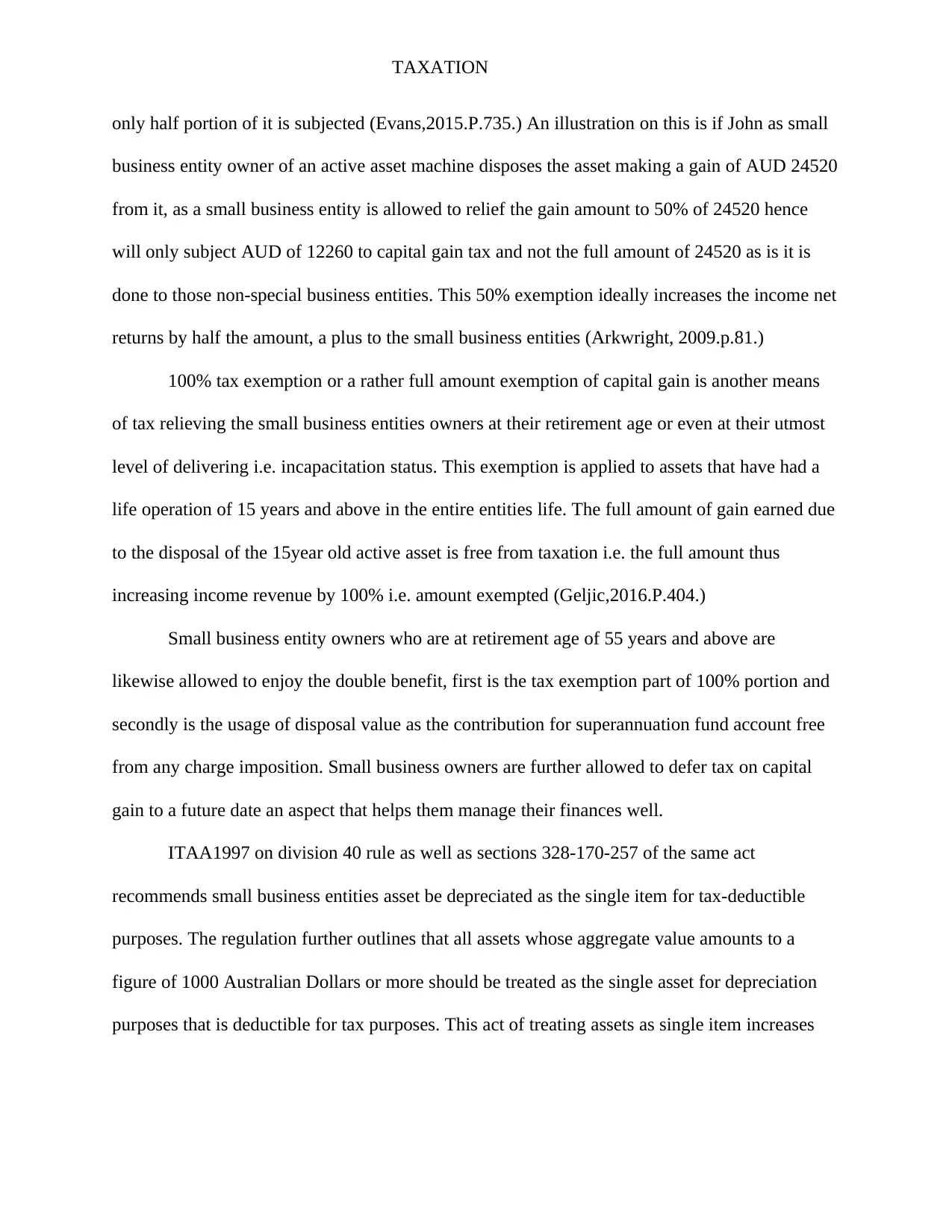
TAXATION
only half portion of it is subjected (Evans,2015.P.735.) An illustration on this is if John as small
business entity owner of an active asset machine disposes the asset making a gain of AUD 24520
from it, as a small business entity is allowed to relief the gain amount to 50% of 24520 hence
will only subject AUD of 12260 to capital gain tax and not the full amount of 24520 as is it is
done to those non-special business entities. This 50% exemption ideally increases the income net
returns by half the amount, a plus to the small business entities (Arkwright, 2009.p.81.)
100% tax exemption or a rather full amount exemption of capital gain is another means
of tax relieving the small business entities owners at their retirement age or even at their utmost
level of delivering i.e. incapacitation status. This exemption is applied to assets that have had a
life operation of 15 years and above in the entire entities life. The full amount of gain earned due
to the disposal of the 15year old active asset is free from taxation i.e. the full amount thus
increasing income revenue by 100% i.e. amount exempted (Geljic,2016.P.404.)
Small business entity owners who are at retirement age of 55 years and above are
likewise allowed to enjoy the double benefit, first is the tax exemption part of 100% portion and
secondly is the usage of disposal value as the contribution for superannuation fund account free
from any charge imposition. Small business owners are further allowed to defer tax on capital
gain to a future date an aspect that helps them manage their finances well.
ITAA1997 on division 40 rule as well as sections 328-170-257 of the same act
recommends small business entities asset be depreciated as the single item for tax-deductible
purposes. The regulation further outlines that all assets whose aggregate value amounts to a
figure of 1000 Australian Dollars or more should be treated as the single asset for depreciation
purposes that is deductible for tax purposes. This act of treating assets as single item increases
only half portion of it is subjected (Evans,2015.P.735.) An illustration on this is if John as small
business entity owner of an active asset machine disposes the asset making a gain of AUD 24520
from it, as a small business entity is allowed to relief the gain amount to 50% of 24520 hence
will only subject AUD of 12260 to capital gain tax and not the full amount of 24520 as is it is
done to those non-special business entities. This 50% exemption ideally increases the income net
returns by half the amount, a plus to the small business entities (Arkwright, 2009.p.81.)
100% tax exemption or a rather full amount exemption of capital gain is another means
of tax relieving the small business entities owners at their retirement age or even at their utmost
level of delivering i.e. incapacitation status. This exemption is applied to assets that have had a
life operation of 15 years and above in the entire entities life. The full amount of gain earned due
to the disposal of the 15year old active asset is free from taxation i.e. the full amount thus
increasing income revenue by 100% i.e. amount exempted (Geljic,2016.P.404.)
Small business entity owners who are at retirement age of 55 years and above are
likewise allowed to enjoy the double benefit, first is the tax exemption part of 100% portion and
secondly is the usage of disposal value as the contribution for superannuation fund account free
from any charge imposition. Small business owners are further allowed to defer tax on capital
gain to a future date an aspect that helps them manage their finances well.
ITAA1997 on division 40 rule as well as sections 328-170-257 of the same act
recommends small business entities asset be depreciated as the single item for tax-deductible
purposes. The regulation further outlines that all assets whose aggregate value amounts to a
figure of 1000 Australian Dollars or more should be treated as the single asset for depreciation
purposes that is deductible for tax purposes. This act of treating assets as single item increases
⊘ This is a preview!⊘
Do you want full access?
Subscribe today to unlock all pages.

Trusted by 1+ million students worldwide
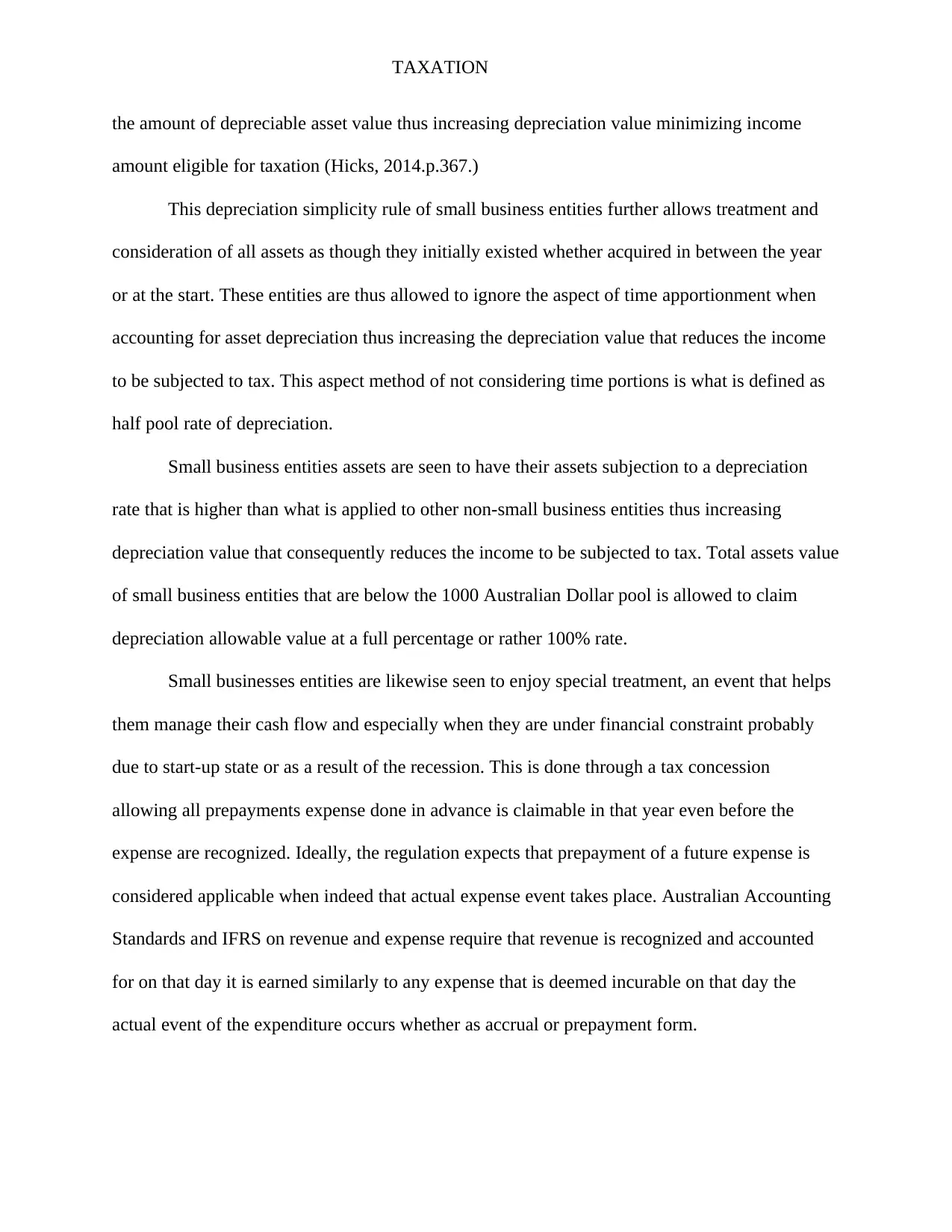
TAXATION
the amount of depreciable asset value thus increasing depreciation value minimizing income
amount eligible for taxation (Hicks, 2014.p.367.)
This depreciation simplicity rule of small business entities further allows treatment and
consideration of all assets as though they initially existed whether acquired in between the year
or at the start. These entities are thus allowed to ignore the aspect of time apportionment when
accounting for asset depreciation thus increasing the depreciation value that reduces the income
to be subjected to tax. This aspect method of not considering time portions is what is defined as
half pool rate of depreciation.
Small business entities assets are seen to have their assets subjection to a depreciation
rate that is higher than what is applied to other non-small business entities thus increasing
depreciation value that consequently reduces the income to be subjected to tax. Total assets value
of small business entities that are below the 1000 Australian Dollar pool is allowed to claim
depreciation allowable value at a full percentage or rather 100% rate.
Small businesses entities are likewise seen to enjoy special treatment, an event that helps
them manage their cash flow and especially when they are under financial constraint probably
due to start-up state or as a result of the recession. This is done through a tax concession
allowing all prepayments expense done in advance is claimable in that year even before the
expense are recognized. Ideally, the regulation expects that prepayment of a future expense is
considered applicable when indeed that actual expense event takes place. Australian Accounting
Standards and IFRS on revenue and expense require that revenue is recognized and accounted
for on that day it is earned similarly to any expense that is deemed incurable on that day the
actual event of the expenditure occurs whether as accrual or prepayment form.
the amount of depreciable asset value thus increasing depreciation value minimizing income
amount eligible for taxation (Hicks, 2014.p.367.)
This depreciation simplicity rule of small business entities further allows treatment and
consideration of all assets as though they initially existed whether acquired in between the year
or at the start. These entities are thus allowed to ignore the aspect of time apportionment when
accounting for asset depreciation thus increasing the depreciation value that reduces the income
to be subjected to tax. This aspect method of not considering time portions is what is defined as
half pool rate of depreciation.
Small business entities assets are seen to have their assets subjection to a depreciation
rate that is higher than what is applied to other non-small business entities thus increasing
depreciation value that consequently reduces the income to be subjected to tax. Total assets value
of small business entities that are below the 1000 Australian Dollar pool is allowed to claim
depreciation allowable value at a full percentage or rather 100% rate.
Small businesses entities are likewise seen to enjoy special treatment, an event that helps
them manage their cash flow and especially when they are under financial constraint probably
due to start-up state or as a result of the recession. This is done through a tax concession
allowing all prepayments expense done in advance is claimable in that year even before the
expense are recognized. Ideally, the regulation expects that prepayment of a future expense is
considered applicable when indeed that actual expense event takes place. Australian Accounting
Standards and IFRS on revenue and expense require that revenue is recognized and accounted
for on that day it is earned similarly to any expense that is deemed incurable on that day the
actual event of the expenditure occurs whether as accrual or prepayment form.
Paraphrase This Document
Need a fresh take? Get an instant paraphrase of this document with our AI Paraphraser
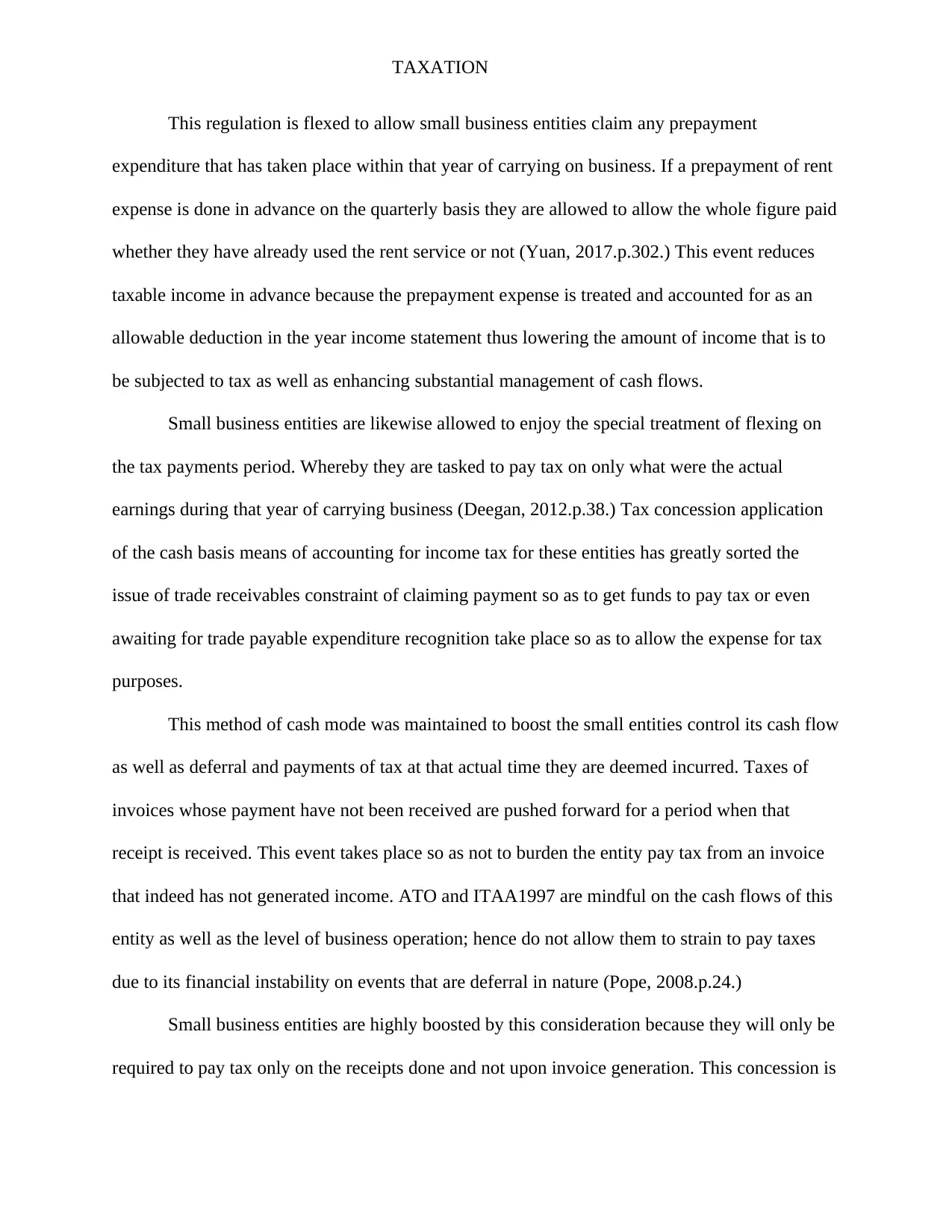
TAXATION
This regulation is flexed to allow small business entities claim any prepayment
expenditure that has taken place within that year of carrying on business. If a prepayment of rent
expense is done in advance on the quarterly basis they are allowed to allow the whole figure paid
whether they have already used the rent service or not (Yuan, 2017.p.302.) This event reduces
taxable income in advance because the prepayment expense is treated and accounted for as an
allowable deduction in the year income statement thus lowering the amount of income that is to
be subjected to tax as well as enhancing substantial management of cash flows.
Small business entities are likewise allowed to enjoy the special treatment of flexing on
the tax payments period. Whereby they are tasked to pay tax on only what were the actual
earnings during that year of carrying business (Deegan, 2012.p.38.) Tax concession application
of the cash basis means of accounting for income tax for these entities has greatly sorted the
issue of trade receivables constraint of claiming payment so as to get funds to pay tax or even
awaiting for trade payable expenditure recognition take place so as to allow the expense for tax
purposes.
This method of cash mode was maintained to boost the small entities control its cash flow
as well as deferral and payments of tax at that actual time they are deemed incurred. Taxes of
invoices whose payment have not been received are pushed forward for a period when that
receipt is received. This event takes place so as not to burden the entity pay tax from an invoice
that indeed has not generated income. ATO and ITAA1997 are mindful on the cash flows of this
entity as well as the level of business operation; hence do not allow them to strain to pay taxes
due to its financial instability on events that are deferral in nature (Pope, 2008.p.24.)
Small business entities are highly boosted by this consideration because they will only be
required to pay tax only on the receipts done and not upon invoice generation. This concession is
This regulation is flexed to allow small business entities claim any prepayment
expenditure that has taken place within that year of carrying on business. If a prepayment of rent
expense is done in advance on the quarterly basis they are allowed to allow the whole figure paid
whether they have already used the rent service or not (Yuan, 2017.p.302.) This event reduces
taxable income in advance because the prepayment expense is treated and accounted for as an
allowable deduction in the year income statement thus lowering the amount of income that is to
be subjected to tax as well as enhancing substantial management of cash flows.
Small business entities are likewise allowed to enjoy the special treatment of flexing on
the tax payments period. Whereby they are tasked to pay tax on only what were the actual
earnings during that year of carrying business (Deegan, 2012.p.38.) Tax concession application
of the cash basis means of accounting for income tax for these entities has greatly sorted the
issue of trade receivables constraint of claiming payment so as to get funds to pay tax or even
awaiting for trade payable expenditure recognition take place so as to allow the expense for tax
purposes.
This method of cash mode was maintained to boost the small entities control its cash flow
as well as deferral and payments of tax at that actual time they are deemed incurred. Taxes of
invoices whose payment have not been received are pushed forward for a period when that
receipt is received. This event takes place so as not to burden the entity pay tax from an invoice
that indeed has not generated income. ATO and ITAA1997 are mindful on the cash flows of this
entity as well as the level of business operation; hence do not allow them to strain to pay taxes
due to its financial instability on events that are deferral in nature (Pope, 2008.p.24.)
Small business entities are highly boosted by this consideration because they will only be
required to pay tax only on the receipts done and not upon invoice generation. This concession is
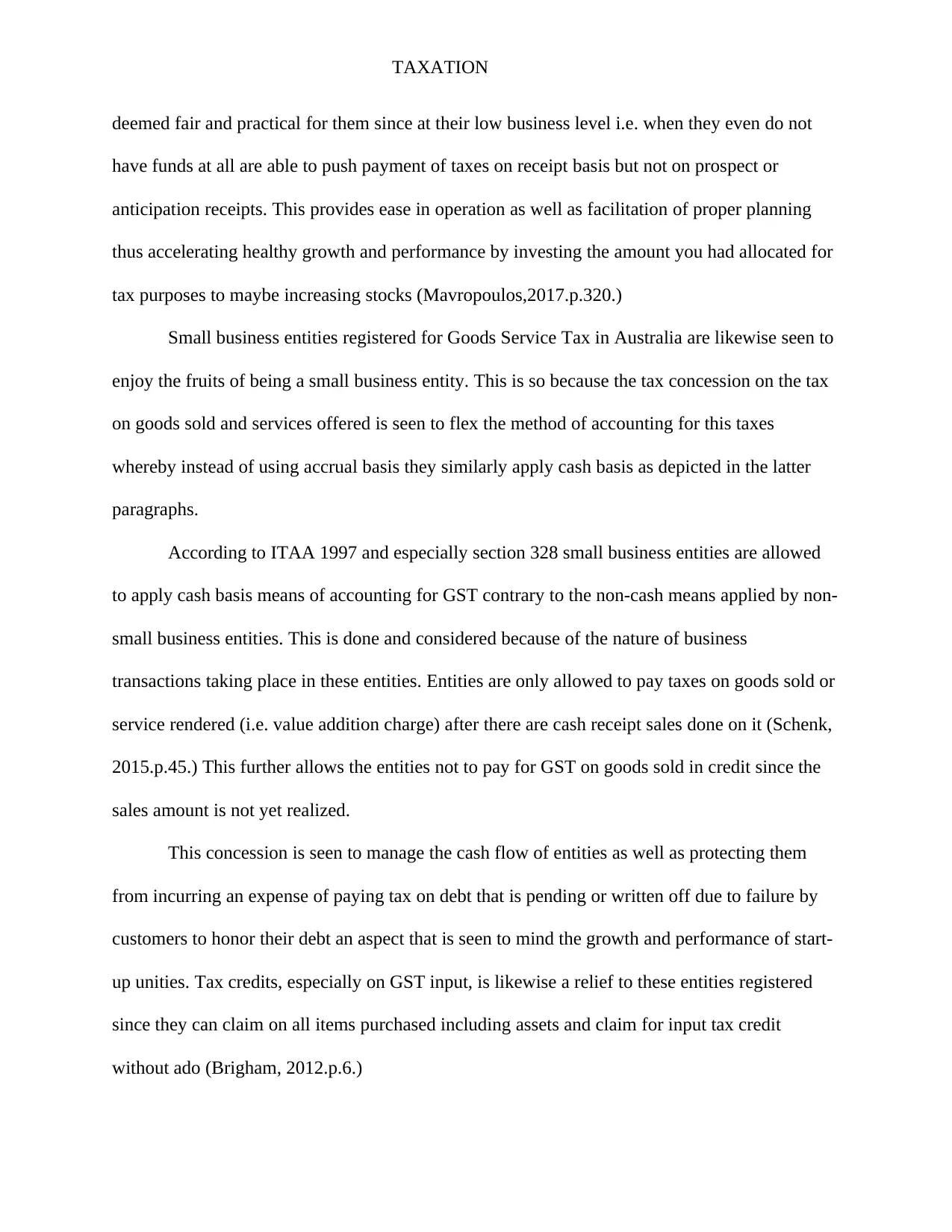
TAXATION
deemed fair and practical for them since at their low business level i.e. when they even do not
have funds at all are able to push payment of taxes on receipt basis but not on prospect or
anticipation receipts. This provides ease in operation as well as facilitation of proper planning
thus accelerating healthy growth and performance by investing the amount you had allocated for
tax purposes to maybe increasing stocks (Mavropoulos,2017.p.320.)
Small business entities registered for Goods Service Tax in Australia are likewise seen to
enjoy the fruits of being a small business entity. This is so because the tax concession on the tax
on goods sold and services offered is seen to flex the method of accounting for this taxes
whereby instead of using accrual basis they similarly apply cash basis as depicted in the latter
paragraphs.
According to ITAA 1997 and especially section 328 small business entities are allowed
to apply cash basis means of accounting for GST contrary to the non-cash means applied by non-
small business entities. This is done and considered because of the nature of business
transactions taking place in these entities. Entities are only allowed to pay taxes on goods sold or
service rendered (i.e. value addition charge) after there are cash receipt sales done on it (Schenk,
2015.p.45.) This further allows the entities not to pay for GST on goods sold in credit since the
sales amount is not yet realized.
This concession is seen to manage the cash flow of entities as well as protecting them
from incurring an expense of paying tax on debt that is pending or written off due to failure by
customers to honor their debt an aspect that is seen to mind the growth and performance of start-
up unities. Tax credits, especially on GST input, is likewise a relief to these entities registered
since they can claim on all items purchased including assets and claim for input tax credit
without ado (Brigham, 2012.p.6.)
deemed fair and practical for them since at their low business level i.e. when they even do not
have funds at all are able to push payment of taxes on receipt basis but not on prospect or
anticipation receipts. This provides ease in operation as well as facilitation of proper planning
thus accelerating healthy growth and performance by investing the amount you had allocated for
tax purposes to maybe increasing stocks (Mavropoulos,2017.p.320.)
Small business entities registered for Goods Service Tax in Australia are likewise seen to
enjoy the fruits of being a small business entity. This is so because the tax concession on the tax
on goods sold and services offered is seen to flex the method of accounting for this taxes
whereby instead of using accrual basis they similarly apply cash basis as depicted in the latter
paragraphs.
According to ITAA 1997 and especially section 328 small business entities are allowed
to apply cash basis means of accounting for GST contrary to the non-cash means applied by non-
small business entities. This is done and considered because of the nature of business
transactions taking place in these entities. Entities are only allowed to pay taxes on goods sold or
service rendered (i.e. value addition charge) after there are cash receipt sales done on it (Schenk,
2015.p.45.) This further allows the entities not to pay for GST on goods sold in credit since the
sales amount is not yet realized.
This concession is seen to manage the cash flow of entities as well as protecting them
from incurring an expense of paying tax on debt that is pending or written off due to failure by
customers to honor their debt an aspect that is seen to mind the growth and performance of start-
up unities. Tax credits, especially on GST input, is likewise a relief to these entities registered
since they can claim on all items purchased including assets and claim for input tax credit
without ado (Brigham, 2012.p.6.)
⊘ This is a preview!⊘
Do you want full access?
Subscribe today to unlock all pages.

Trusted by 1+ million students worldwide
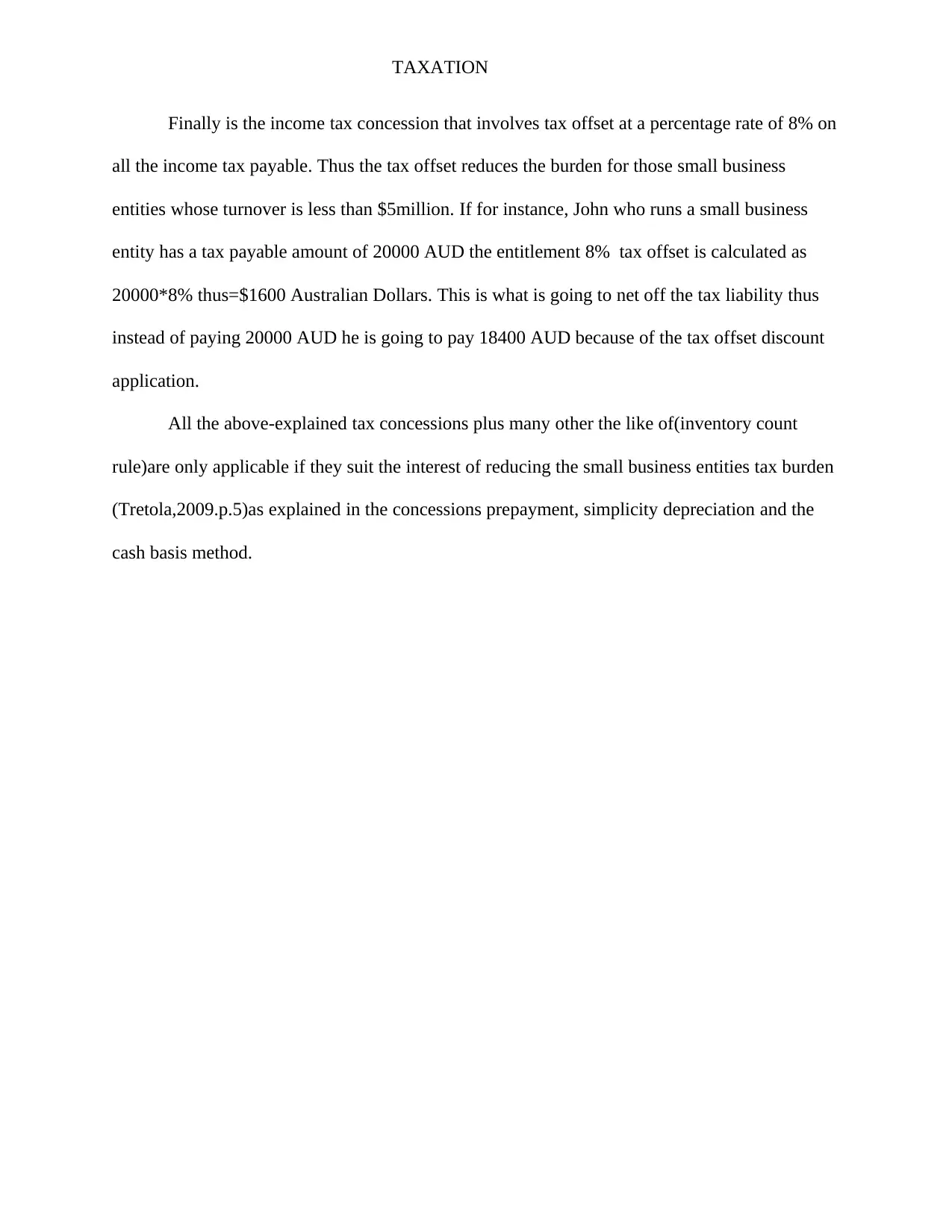
TAXATION
Finally is the income tax concession that involves tax offset at a percentage rate of 8% on
all the income tax payable. Thus the tax offset reduces the burden for those small business
entities whose turnover is less than $5million. If for instance, John who runs a small business
entity has a tax payable amount of 20000 AUD the entitlement 8% tax offset is calculated as
20000*8% thus=$1600 Australian Dollars. This is what is going to net off the tax liability thus
instead of paying 20000 AUD he is going to pay 18400 AUD because of the tax offset discount
application.
All the above-explained tax concessions plus many other the like of(inventory count
rule)are only applicable if they suit the interest of reducing the small business entities tax burden
(Tretola,2009.p.5)as explained in the concessions prepayment, simplicity depreciation and the
cash basis method.
Finally is the income tax concession that involves tax offset at a percentage rate of 8% on
all the income tax payable. Thus the tax offset reduces the burden for those small business
entities whose turnover is less than $5million. If for instance, John who runs a small business
entity has a tax payable amount of 20000 AUD the entitlement 8% tax offset is calculated as
20000*8% thus=$1600 Australian Dollars. This is what is going to net off the tax liability thus
instead of paying 20000 AUD he is going to pay 18400 AUD because of the tax offset discount
application.
All the above-explained tax concessions plus many other the like of(inventory count
rule)are only applicable if they suit the interest of reducing the small business entities tax burden
(Tretola,2009.p.5)as explained in the concessions prepayment, simplicity depreciation and the
cash basis method.
Paraphrase This Document
Need a fresh take? Get an instant paraphrase of this document with our AI Paraphraser
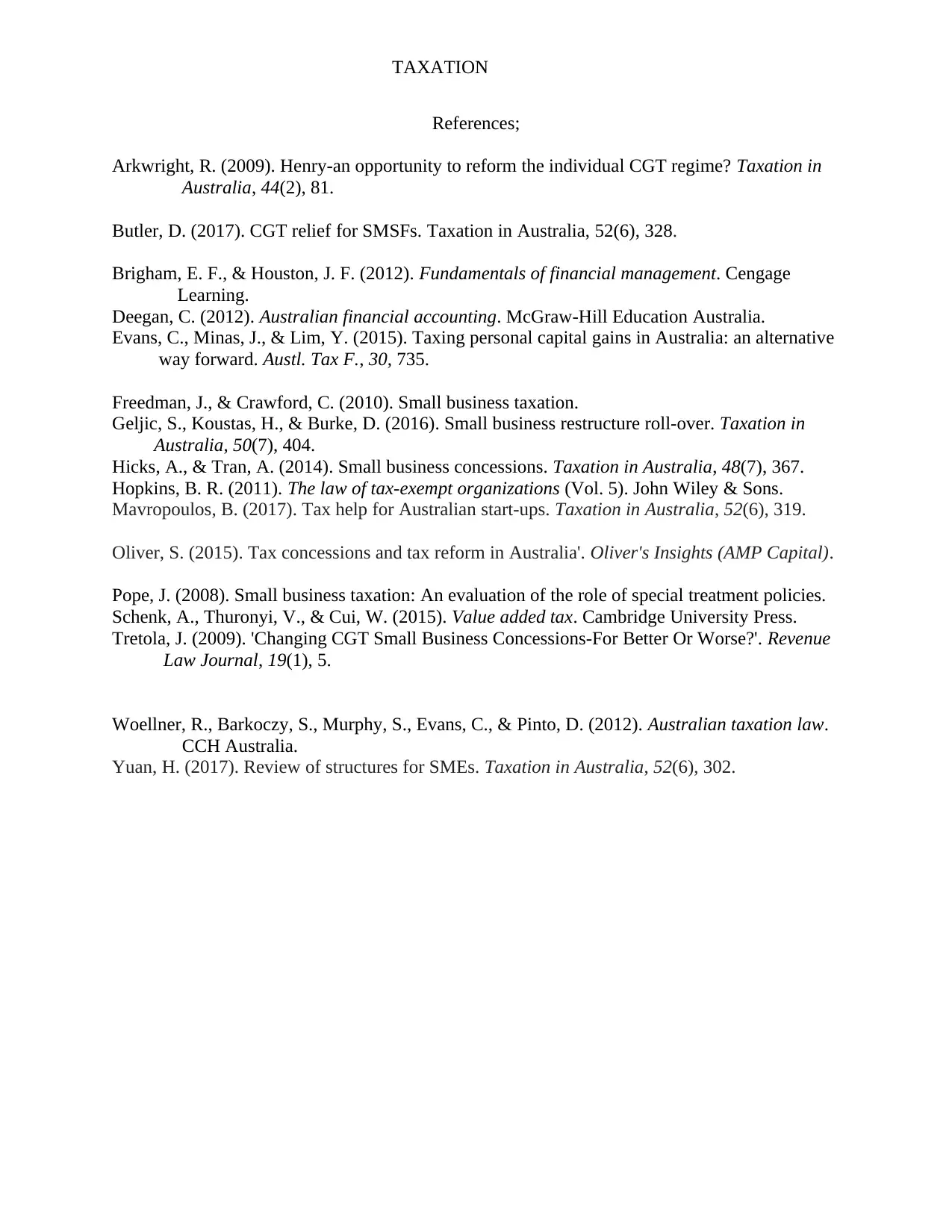
TAXATION
References;
Arkwright, R. (2009). Henry-an opportunity to reform the individual CGT regime? Taxation in
Australia, 44(2), 81.
Butler, D. (2017). CGT relief for SMSFs. Taxation in Australia, 52(6), 328.
Brigham, E. F., & Houston, J. F. (2012). Fundamentals of financial management. Cengage
Learning.
Deegan, C. (2012). Australian financial accounting. McGraw-Hill Education Australia.
Evans, C., Minas, J., & Lim, Y. (2015). Taxing personal capital gains in Australia: an alternative
way forward. Austl. Tax F., 30, 735.
Freedman, J., & Crawford, C. (2010). Small business taxation.
Geljic, S., Koustas, H., & Burke, D. (2016). Small business restructure roll-over. Taxation in
Australia, 50(7), 404.
Hicks, A., & Tran, A. (2014). Small business concessions. Taxation in Australia, 48(7), 367.
Hopkins, B. R. (2011). The law of tax-exempt organizations (Vol. 5). John Wiley & Sons.
Mavropoulos, B. (2017). Tax help for Australian start-ups. Taxation in Australia, 52(6), 319.
Oliver, S. (2015). Tax concessions and tax reform in Australia'. Oliver's Insights (AMP Capital).
Pope, J. (2008). Small business taxation: An evaluation of the role of special treatment policies.
Schenk, A., Thuronyi, V., & Cui, W. (2015). Value added tax. Cambridge University Press.
Tretola, J. (2009). 'Changing CGT Small Business Concessions-For Better Or Worse?'. Revenue
Law Journal, 19(1), 5.
Woellner, R., Barkoczy, S., Murphy, S., Evans, C., & Pinto, D. (2012). Australian taxation law.
CCH Australia.
Yuan, H. (2017). Review of structures for SMEs. Taxation in Australia, 52(6), 302.
References;
Arkwright, R. (2009). Henry-an opportunity to reform the individual CGT regime? Taxation in
Australia, 44(2), 81.
Butler, D. (2017). CGT relief for SMSFs. Taxation in Australia, 52(6), 328.
Brigham, E. F., & Houston, J. F. (2012). Fundamentals of financial management. Cengage
Learning.
Deegan, C. (2012). Australian financial accounting. McGraw-Hill Education Australia.
Evans, C., Minas, J., & Lim, Y. (2015). Taxing personal capital gains in Australia: an alternative
way forward. Austl. Tax F., 30, 735.
Freedman, J., & Crawford, C. (2010). Small business taxation.
Geljic, S., Koustas, H., & Burke, D. (2016). Small business restructure roll-over. Taxation in
Australia, 50(7), 404.
Hicks, A., & Tran, A. (2014). Small business concessions. Taxation in Australia, 48(7), 367.
Hopkins, B. R. (2011). The law of tax-exempt organizations (Vol. 5). John Wiley & Sons.
Mavropoulos, B. (2017). Tax help for Australian start-ups. Taxation in Australia, 52(6), 319.
Oliver, S. (2015). Tax concessions and tax reform in Australia'. Oliver's Insights (AMP Capital).
Pope, J. (2008). Small business taxation: An evaluation of the role of special treatment policies.
Schenk, A., Thuronyi, V., & Cui, W. (2015). Value added tax. Cambridge University Press.
Tretola, J. (2009). 'Changing CGT Small Business Concessions-For Better Or Worse?'. Revenue
Law Journal, 19(1), 5.
Woellner, R., Barkoczy, S., Murphy, S., Evans, C., & Pinto, D. (2012). Australian taxation law.
CCH Australia.
Yuan, H. (2017). Review of structures for SMEs. Taxation in Australia, 52(6), 302.
1 out of 8
Related Documents
Your All-in-One AI-Powered Toolkit for Academic Success.
+13062052269
info@desklib.com
Available 24*7 on WhatsApp / Email
![[object Object]](/_next/static/media/star-bottom.7253800d.svg)
Unlock your academic potential
Copyright © 2020–2025 A2Z Services. All Rights Reserved. Developed and managed by ZUCOL.





